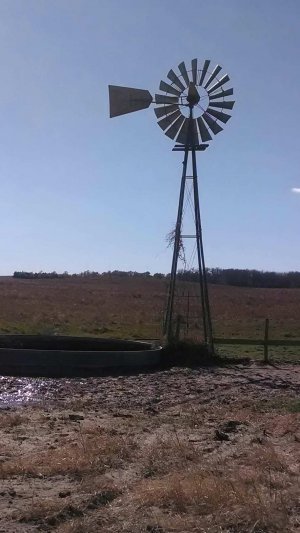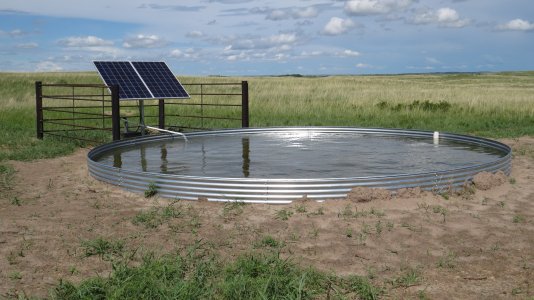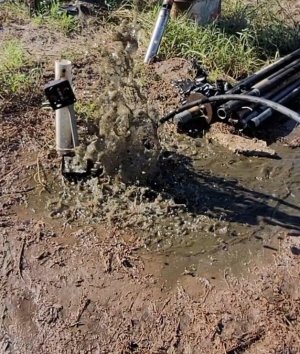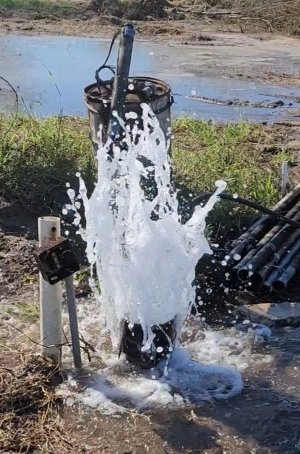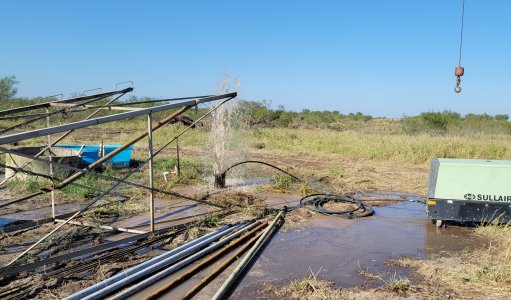necattle
Member
- Joined
- Jun 16, 2012
- Messages
- 18
- Reaction score
- 28
Livestock health is of utmost importance to all of us. Adding vinegar to water supply is becoming increasing popular due to vinegar clears murky water in ponds and dam scenarios, is believed to help calves gain in summer months, and the vinegar smell definately decreases fly's desire to infest cowherds. I have found this to be absolutely right on. I started with vinegar to begin the all organic process.
Adding garlic to mineral has been a real success this year and a cheap additive. I borrowed Vita Ferm's concept aid formula but added or increased certain percentages of certain minerals to Concept Aid then had the local local co op mix it for me. Great for fertility/breed back.
The second is clean water. I have removed all windmills and installed solar wells with grundfos sqf 11 AC/DC pumps with the upgraded controller that utilizes a float so the pump turns off when the tank is full so there is no over flow. This sqf 11 produces 11 gallons per minute and even pumps a little in snow storms! They are cheaper than a new windmill and no more climbing and potentially falling for aging ranchers. "Too many of us."
This will water 250 head of cow calf pairs in the hottest two weeks of the year. No more moving cattle in the early morning because the wind has not been blowing for 2-3 days. I am in the Sandhills of Nebraska.
Lastly, by letting the cattle drink down in the wintertime to a half tank of water, we manually turn on the pump and when we go to feed in the morning we turn the well on first thing. By the time we are done the well has pumped 11 gallons per minute of 52 degree water on top of the ice. Due to melting existing ice and the fact that the cattle do not drink as much water in the winter time, we have not chopped ice since the solar wells have gone in.
One last tip, I do not know why but by bottoming out the pump in the well and raising it 4 ft means the chance of running a well dry when you first fire up the well works great due to recharge of the solar well with a faster pumping rate can shut the pump down until the water recharges. Grundfos has a sensor that turns the pump off if there is no water so the unit does not get burned out. This for us has happened two times but has also gone away after a few days when it does happen, never to happen again. With a higher pumping rate the recharge of the well water takes time to acclimate to the higher demand of the solar well versus a windmill. What we have found is that with two wells, one pumping at a shallower distance versus the deeper solar well is so popular with the cattle they all virtually go to the solar well. This must mean the water is sweeter tasting pumping from the deeper location of the water. Both wells originally the same depth.
I lied, there's more. Without the water overflow due to the float turning off the water when the tank is full means weight gain. When it gets hot our angus cattle would hole up in the ponding over flow basin which is dirty water. Calves can not suck cows during the day when the cows stand in the water for hours at a time. The cows are not grazing while in the water cooling down and they don't graze as far away as they could with limited grazing hours meaning the pasture gets potentially overgrazed the closer to the well you get.
Good water equals Great Herd Health!
First Solar Well. Solar Panels $250, Grundfos Pump n float $1900, Continuous panels and 8 inch corner posts $300, Misc suplies equals $3500 for solar well. New tank not included. Solar Well guys are very expensive and have a very large profit on solar right now, at least in Ne versus a windmill. By selling my old windmill and motor, I received $1500 for it and with depreciation on the new improvement the new well ran me under $1200. It actually was less than that for me because I had contacts and did the solar well for $2950. Once you swap out a windmill for solar you will see the well guys are not needed. Grundfos is by far and way the best with the best warranties and customer service but also the most expensive. The float/controller adds substantially to the life span of the pump and so much less water is pumped out of the ground. This saves valuable opperating lifespan for the pumps and decreases service issues. Labor $0.00. Mileage $0.00. And as always, I offer myself timely service with a true appreciation of my customer. Me!
For plains hunters, there is no sound to the system other than the sound of water splashing into water. Antelope and deer both like quiet water to come to every day.
Hope this helps on water and herd health.
My first post
Gary
Sioux Angus
Adding garlic to mineral has been a real success this year and a cheap additive. I borrowed Vita Ferm's concept aid formula but added or increased certain percentages of certain minerals to Concept Aid then had the local local co op mix it for me. Great for fertility/breed back.
The second is clean water. I have removed all windmills and installed solar wells with grundfos sqf 11 AC/DC pumps with the upgraded controller that utilizes a float so the pump turns off when the tank is full so there is no over flow. This sqf 11 produces 11 gallons per minute and even pumps a little in snow storms! They are cheaper than a new windmill and no more climbing and potentially falling for aging ranchers. "Too many of us."
This will water 250 head of cow calf pairs in the hottest two weeks of the year. No more moving cattle in the early morning because the wind has not been blowing for 2-3 days. I am in the Sandhills of Nebraska.
Lastly, by letting the cattle drink down in the wintertime to a half tank of water, we manually turn on the pump and when we go to feed in the morning we turn the well on first thing. By the time we are done the well has pumped 11 gallons per minute of 52 degree water on top of the ice. Due to melting existing ice and the fact that the cattle do not drink as much water in the winter time, we have not chopped ice since the solar wells have gone in.
One last tip, I do not know why but by bottoming out the pump in the well and raising it 4 ft means the chance of running a well dry when you first fire up the well works great due to recharge of the solar well with a faster pumping rate can shut the pump down until the water recharges. Grundfos has a sensor that turns the pump off if there is no water so the unit does not get burned out. This for us has happened two times but has also gone away after a few days when it does happen, never to happen again. With a higher pumping rate the recharge of the well water takes time to acclimate to the higher demand of the solar well versus a windmill. What we have found is that with two wells, one pumping at a shallower distance versus the deeper solar well is so popular with the cattle they all virtually go to the solar well. This must mean the water is sweeter tasting pumping from the deeper location of the water. Both wells originally the same depth.
I lied, there's more. Without the water overflow due to the float turning off the water when the tank is full means weight gain. When it gets hot our angus cattle would hole up in the ponding over flow basin which is dirty water. Calves can not suck cows during the day when the cows stand in the water for hours at a time. The cows are not grazing while in the water cooling down and they don't graze as far away as they could with limited grazing hours meaning the pasture gets potentially overgrazed the closer to the well you get.
Good water equals Great Herd Health!
First Solar Well. Solar Panels $250, Grundfos Pump n float $1900, Continuous panels and 8 inch corner posts $300, Misc suplies equals $3500 for solar well. New tank not included. Solar Well guys are very expensive and have a very large profit on solar right now, at least in Ne versus a windmill. By selling my old windmill and motor, I received $1500 for it and with depreciation on the new improvement the new well ran me under $1200. It actually was less than that for me because I had contacts and did the solar well for $2950. Once you swap out a windmill for solar you will see the well guys are not needed. Grundfos is by far and way the best with the best warranties and customer service but also the most expensive. The float/controller adds substantially to the life span of the pump and so much less water is pumped out of the ground. This saves valuable opperating lifespan for the pumps and decreases service issues. Labor $0.00. Mileage $0.00. And as always, I offer myself timely service with a true appreciation of my customer. Me!
For plains hunters, there is no sound to the system other than the sound of water splashing into water. Antelope and deer both like quiet water to come to every day.
Hope this helps on water and herd health.
My first post
Gary
Sioux Angus
Attachments
Last edited:

